Note: If an image ever fails to appear - refresh your page, it really is there
The History of the Imperial German War Flag (1867-1921)
written and edited by "Fornax" and Pete Loeser
The history of the War Flag began shortly after the creation of the North German Confederation in 1866. This confederation was comprised of many of the smaller Germanic states formed after the end of the Napoleonic Wars in Europe, with the Kingdom of Prussia acting as the leading state. It basically consisted of all the German states north of the river Main. Its head of state was the Prussian King Wilhelm I. For the newly established country, it was necessary to create a National Civil Flag as well as a military War Flag. While for the National flag the colors Black-White-Red in a horizontally striped version were chosen, the War Flag looked somewhat different. It was decided that the War Flag must contain a black "Scandinavian Cross." Such a black cross on a white field had already been the symbol of the "Teutonic Knights" in the 12th Century. The Commander-in-Chief of the North German Navy was Adalbert of Prussia, and he was very interested in flag creations. So he made the first attempt to design a War Flag. This flag design contained three very important Germanic symbols: the Scandinavian cross, the National colors and the Prussian Eagle.
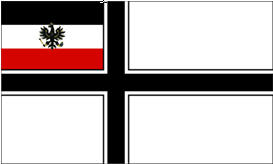 Proposed War flag by Adalbert of Prussia Proposed War flag by Adalbert of Prussia King Wilhelm did agree to the draft, but with one exception: He insisted on adding the Iron Cross that had been part of the War Flag of Prussia since 1818. So the eagle was moved to the intersection of the Scandinavian cross and put on a white disk, while the Iron Cross was set on the white stripe of the National Colors. The first time this new flag was hoisted on ships of the North German Navy was on October 1, 1867.
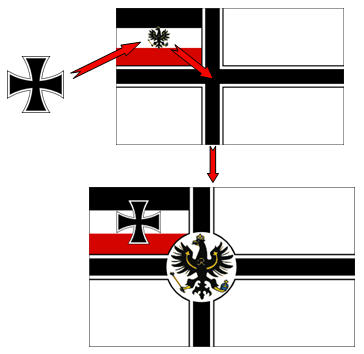 The War Flag of the North German Confederation - July 4, 1867 The War Flag of the North German Confederation - July 4, 1867 The establishment of this North German State was a provocation for France, who was the geographical neighbor in the west. This friction between France and North Germany finally led to the Franco-Prussian War of 1870-1871. Many south German states (Bavaria, Württemberg and others) united with the states of the Federation to fight France. The Confederation emerged victorious, which led to the creation of the German Empire in 1871. Since Prussia remained the leading power, it was decided to continue using the symbols of North Germany for the new Reich (empire). Because of this, the War flag of the North German Confederation also became the Imperial War Flag of the newly established German Empire.
 The Imperial War Flag - 1871 The Imperial War Flag - 1871 Although, the War flag was originally intended to be only the flag used at sea, it was decided in 1892 that it also would be the official flag used by the German Army on land. Possibly because of this change, but probably simply because of artistic reasons, on December 19, 1892, the flag got a new eagle.
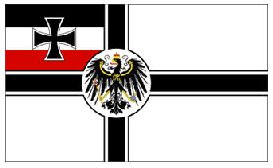 The Imperial War Flag - December 19, 1892 The Imperial War Flag - December 19, 1892 Because it is not always easy to distinguish flags used at sea, especially when weather or lighting conditions are bad, it sometimes almost impossible to identify a flag hoisted on a ship. Because of this, in 1903, an incident at sea led to another alteration of the flag. It was discovered that the German War Flag could resemble the British "White Ensign" when the conditions were bad and the distances were long.
|
The British "White Ensign" |
In 1903, a Russian warship, which encountered a German one, inadvertently hoisted the British "White Ensign" instead of the German War Flag for the purpose of a salute, which was considered a great insult at the time. This eventually led the German Emperor Wilhelm II to change the War Flag again. He ordered that the black Scandinavian Cross and the black border line of the central disk to be considerably widened. The black border line was also to be displayed in a continuous fashion.
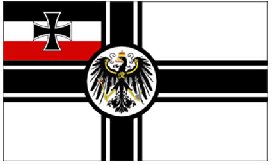 The Imperial War Flag - September 26, 1903 The Imperial War Flag - September 26, 1903 After Germany had lost World War I in 1918, Germany became a republic. The new "Weimar Republic" began to change all national colors and symbols. The National flag was altered, and henceforth displayed the colors Black-Red-Yellow (Gold). On September 27, 1919, a new War Flag was adopted. It resembled the old Imperial War Flag, but of two differences: The Prussian eagle was replaced by the new republican design and the new national colors were displayed in the upper left corner.
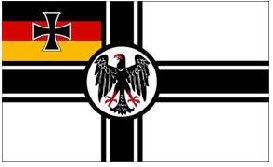 Adopted War Flag - September 27, 1919 (never used) Adopted War Flag - September 27, 1919 (never used) The leadership of the German Navy was still conservative and did not accept the new republican design. They refused to hoist the new version and insisted upon the continued use of the old Imperial War Flag of the German Empire. Because of this, the republican design - although produced to some extent - was never used and hoisted on a German warship or anywhere else. The navy continued displaying the Imperial War Flag. On January 1, 1922, an entirely new design replaced the War Flag of the German Empire.
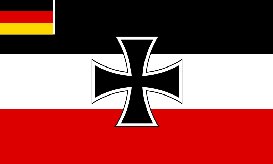 Germany War Flag - January 1, 1922 Germany War Flag - January 1, 1922 A lot of "right wing" fractions and groups continued to use the Imperial War Flag after 1919 in order to show their political attitudes. This practice has continued down to the present day in Germany.
| Top of Page | Return to "Flags of the Third Reich" | Return to "World War II Flags: Axis Powers" |
| Return to "Historical Flags of Germany" | Return to "Vexillological Essays and Chart Pages Menu" |
|